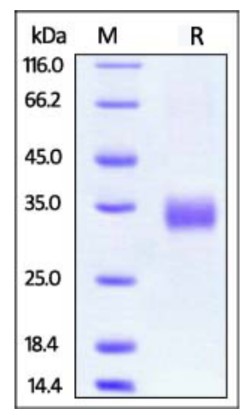FCGR2A
-
Official Full Name
Fc fragment of IgG, low affinity IIa, receptor (CD32) -
Overview
This gene encodes one member of a family of immunoglobulin Fc receptor genes found on the surface of many immune response cells. The protein encoded by this gene is a cell surface receptor found on phagocytic cells such as macrophages and neutrophils, and is involved in the process of phagocytosis and clearing of immune complexes. Alternative splicing results in multiple transcript variants. -
Synonyms
FCGR2A;Fc fragment of IgG, low affinity IIa, receptor (CD32);CD32;FCG2;FcGR;CD32A;CDw32;FCGR2;IGFR2;FCGR2A1
Recombinant Proteins
- Human
- Cynomolgus
- Rhesus macaque
- Rat
- Mouse
- HEK293
- Human Cells
- E.coli
- Insect Cells
- Mammalian Cells
- Wheat Germ
- CHO
- Cynomolgus
- Mouse myeloma cell
- Yeast
- In Vitro Cell Free System
- His
- Avi
- GST
- Fc
- Non
- Flag
Background

Fig1. FCGR2A-related protein interaction network. (Yongmei Dai, 2021)
What is FCGR2A protein?
FCGR2A (Fc gamma receptor IIa) gene is a protein coding gene which situated on the long arm of chromosome 1 at locus 1q23. This gene encodes one member of a family of immunoglobulin Fc receptor genes found on the surface of many immune response cells. The FCGR2A protein encoded by this gene is a cell surface receptor found on phagocytic cells such as macrophages and neutrophils, and is involved in the process of phagocytosis and clearing of immune complexes. FCGR2A is expressed on cells of both myeloid and lymphoid lineages as well as on cells of non-hematopoietic origin. This protein is consisted of 317 amino acids and is approximately 35 kDa.
What is the Function of FCGR2A protein?
Associated with an ITAM (immunoreceptor tyrosine-based activation motif)- bearing adapter subunit, FCGR2A delivers an activating signal upon ligand binding, and results in the initiation of inflammatory responses including cytolysis, phagocytosis, degranulation and cytokine production. It can also bind to IgG antibodies to promote the phagocytosis and destruction of immune cells (such as monocytes, macrophages, and dendritic cells) against pathogens or foreign bodies labeled by antibodies, thereby enhancing antibody-mediated cytotoxicity.
FCGR2A Related Signaling Pathway
When FCGR2A binds to the Fc part of IgG antibody, it activates the downstream signaling pathway through the ITAM region in its cytoplasm. These signaling pathways, including Syk tyrosine kinase, PI3K/Akt, NF-κB, etc., regulate the activation, proliferation, and inflammatory response of macrophages, dendritic cells, and B cells.
FCGR2A Related Diseases
FCGR2A gene mutation may lead to the occurrence of autoimmune diseases, such as rheumatoid arthritis, systemic lupus erythematosus and so on. It may also lead to the occurrence of allergic diseases, such as asthma and allergic rhinitis. Other research reports FCGR2A functional genetic variant is associated with susceptibility to severe malarial anaemia in Ghanaian children.
Bioapplications of FCGR2A
The anti-ige antibody drug Omalizumab inhibits the FCGR2A signaling pathway by binding to IgE antibodies, thereby reducing allergic reactions. At the same time, some studies are exploring the use of gene editing technology to change the expression level of FCGR2A in order to achieve better immunomodulatory effects.
Case Study
Case Study 1: Wei Liao, 2023

Fig1. Immunofluorescence staining detected expression of key genes in PC12 and H9c2 cells and hypoxia-reoxygenated cell models (bar = 50 μm).
Case Study 2: Xin Zhao, 2021

Fig2. The expression of EREG, FCGR2A, CCL4L2, and CTSC increases from the normal pancreas to PASC.
Quality Guarantee
High Purity

Fig1. SDS-PAGE (FCGR2A-352H) (PROTOCOL for western blot)
.

Fig2. Activity Data. (FCGR2A-333H)
Involved Pathway
FCGR2A involved in several pathways and played different roles in them. We selected most pathways FCGR2A participated on our site, such as Phagosome,Osteoclast differentiation,Platelet activation, which may be useful for your reference. Also, other proteins which involved in the same pathway with FCGR2A were listed below. Creative BioMart supplied nearly all the proteins listed, you can search them on our site.
| Pathway Name | Pathway Related Protein |
|---|---|
| Leishmaniasis | HLA-DPA1,CR1,FCGR4,MARCKSL1,IFNGR2,ELK1,PTGS2,MAPK3,NCF2,HLA-DRB3 |
| Tuberculosis | BCL10,PPP3R2,IFNA17,HSPD1,MAPK3,CALML5,RHOA,NFYC,SPHK2,ITGB2L |
| Platelet activation | PLA2G4F,PRKACG,PRKACA,GNAS,GUCY1B3,GP6,GUCY1A3,SYK,PLCB2,GNAI3 |
| Phagosome | TUBA8L,Cd209g,ITGB1,MHC1UEA,BMA2,SFTPA1,HBL4,THBS3A,ITGB1B.2,RAB7 |
| Osteoclast differentiation | FOSL2,SIRPG,TEC,TRAF6,PIK3R2,AKT1,PLCG2,LILRB1,MAPK10,SIRPA |
| Fc gamma R-mediated phagocytosis | PRKCD,PRKCB,PLD1,LAT,VAV3,PAK1,PIK3CA,LYN,MAPK3,VASP |
| Staphylococcus aureus infection | HLA-DMA,HLA-DQB1,FCGR2C,ITGAL,C1QC,SELPLG,FCGR1A,FGG,GM5077,HLA-DOA |
| Systemic lupus erythematosus | HIST1H4N,H2AFX,HLA-DOB,HIST1H2AO,HIST1H4F,HIST1H3I,HIST1H2AA,HIST1H2BB,HLA-DRA,H2AFV |

Fig2. Model of potential impacts of Kawasaki disease (KD) associated genetic variants PELI1, ITPKC, FCGR2A, and genetic polymorphisms in STING and STAT3 on TLR/inflammasome/IFN dysregulation, which might lead to predisposition to COVID-19 related MIS-C. (Chin-An Yang, 2022)
Protein Function
FCGR2A has several biochemical functions, for example, IgG binding,protein binding. Some of the functions are cooperated with other proteins, some of the functions could acted by FCGR2A itself. We selected most functions FCGR2A had, and list some proteins which have the same functions with FCGR2A. You can find most of the proteins on our site.
| Function | Related Protein |
|---|---|
| protein binding | XBP1,YBX1,MTAP1A,LAX1,MCM5,TROAP,RHNO1,CAML,RNF165,COIL |
| IgG binding | FCGR1,FCGRT,PIP,FCGR3B,CD247L,FCGR2B,FCGR2C,FCGR3A,UMOD,FCGR1B |
Interacting Protein
FCGR2A has direct interactions with proteins and molecules. Those interactions were detected by several methods such as yeast two hybrid, co-IP, pull-down and so on. We selected proteins and molecules interacted with FCGR2A here. Most of them are supplied by our site. Hope this information will be useful for your research of FCGR2A.
UBQLN1;UBQLN1;drozitumab;CRP;SYK
Resources
Related Services
Related Products
References
- Carmona, FD; Martin, J; et al. Genetics of vasculitis. CURRENT OPINION IN RHEUMATOLOGY 27:10-17(2015).
- Amirkhosravi, A; Boulaftali, Y; et al. CalDAG-GEFI deficiency protects mice from Fc gamma RIIa-mediated thrombotic thrombocytopenia induced by CD40L and beta 2GPI immune complexes. JOURNAL OF THROMBOSIS AND HAEMOSTASIS 12:2113-2119(2014).




